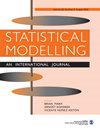半参数密度过程的离群值调节:南极雪密度模拟的研究
IF 1.2
4区 数学
Q2 STATISTICS & PROBABILITY
引用次数: 2
摘要
在许多情况下,数据采集会产生异常值,从而模糊推理。因此,从业者通常要么识别并去除异常值,要么使用稳健的模型来适应异常值。然而,识别和去除异常值通常是一个影响推理的特殊过程,而稳健的方法对于某些应用程序来说往往过于简单。在我们的应用中,科学家们钻取雪芯并测量雪密度,以推断致密化率,这有助于估计雪水积聚率和冰川质量平衡。先进的测量技术可以在深度上以高分辨率测量密度,但对核心缺陷很敏感,容易出现异常值。异常值调节在这种情况下是具有挑战性的,因为异常值的分布随着深度的变化而变化,并且数据显示出自然的异方差。为了应对这些挑战,我们提出了一个双组分混合模型,该模型使用了一个物理驱动的雪密度模型和一个异常值模型,这两个模型都随着深度的变化而变化。混合模型的物理分量具有具有正态分布的深度相关异方差误差的均值函数。使用通过对数正态随机变量的归一化过程卷积构建的半参数先验密度过程来指定异常值分量。我们证明,该模型优于其他模型,可用于各种推理任务。本文章由计算机程序翻译,如有差异,请以英文原文为准。
Outlier accommodation with semiparametric density processes: A study of Antarctic snow density modelling
In many settings, data acquisition generates outliers that can obscure inference. Therefore, practitioners often either identify and remove outliers or accommodate outliers using robust models. However, identifying and removing outliers is often an ad hoc process that affects inference, and robust methods are often too simple for some applications. In our motivating application, scientists drill snow cores and measure snow density to infer densification rates that aid in estimating snow water accumulation rates and glacier mass balances. Advanced measurement techniques can measure density at high resolution over depth but are sensitive to core imperfections, making them prone to outliers. Outlier accommodation is challenging in this setting because the distribution of outliers evolves over depth and the data demonstrate natural heteroscedasticity. To address these challenges, we present a two-component mixture model using a physically motivated snow density model and an outlier model, both of which evolve over depth. The physical component of the mixture model has a mean function with normally distributed depth-dependent heteroscedastic errors. The outlier component is specified using a semiparametric prior density process constructed through a normalized process convolution of log-normal random variables. We demonstrate that this model outperforms alternatives and can be used for various inferential tasks.
求助全文
通过发布文献求助,成功后即可免费获取论文全文。
去求助
来源期刊

Statistical Modelling
数学-统计学与概率论
CiteScore
2.20
自引率
0.00%
发文量
16
审稿时长
>12 weeks
期刊介绍:
The primary aim of the journal is to publish original and high-quality articles that recognize statistical modelling as the general framework for the application of statistical ideas. Submissions must reflect important developments, extensions, and applications in statistical modelling. The journal also encourages submissions that describe scientifically interesting, complex or novel statistical modelling aspects from a wide diversity of disciplines, and submissions that embrace the diversity of applied statistical modelling.
 求助内容:
求助内容: 应助结果提醒方式:
应助结果提醒方式:


